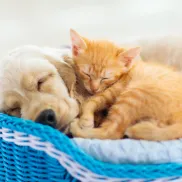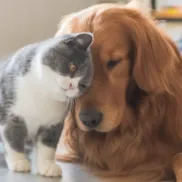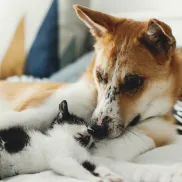What every cat owner should know about feline kidney disease
On a normal day, Luna, your loving orange tabby, wakes you up before the alarm clock goes off. You’re used to being greeted with her meows just inches from your face. But you notice she’s been sleeping in more these days – and pays more attention to her water bowl than her food bowl. Not to mention, her breath is not particularly pleasant.
In Luna’s situation, you aren’t sure why she’s acting different. But based on what you know about cats, you suspect she might have feline kidney disease. So, you make the wise choice to call the vet.
What is feline kidney disease?
While it may sound like some complicated medical term, kidney disease really just describes when a cat’s kidneys start to lose function. Feline kidney disease can be caused by a number of conditions, everything from bacterial infection to genetics.
Just like our kidneys, a cat’s kidney’s primary function is to filter waste and toxins out of the blood and into urine. Their secondary function is to regulate mineral levels and trigger the production of red blood cells (which carry oxygen throughout their body).
There are two types of kidney disease: acute (singular incident, short-term) and chronic (progressive, long-term).
What is acute kidney disease?
Acute kidney disease is generally the result of a specific incident. Examples include ingesting poison, accidents, bacterial infection (among a number of other things). It can happen suddenly to cats of any age and if caught early enough, it can often be reversed.
What is chronic kidney disease?
Chronic kidney disease is more common and it means one or both kidneys have been damaged. It’s commonly seen in middle to old-age cats and is more gradual over months and years. The damage could have been caused by a previous infection or other disease, and sometimes it’s entirely unknown. How severe the damage is will determine how long it will take for their kidney function to decrease.
Signs of feline kidney disease
It can be hard to tell when kidney disease first starts – as we know how well cats can hide their pain.
See your vet if you notice your cat experiencing any of the following symptoms:
- Weakness
- Weight loss
- Lack of appetite
- Vomiting
- Bad breath
- Mouth ulcers
- Increase in water intake
- Frequent urination
- Fur is dull and thinning
The most likely way to catch it early — before they start showing symptoms — is to take your cat in for a yearly wellness testing. If your cat has high blood pressure or their urinalysis results show high levels of protein, these are two indicators their kidneys might be having problems.
Tips for helping prevent kidney failure in cats
As we mentioned previously, if your cat ingests something poisonous (like house plants, human medications, insecticides or household cleaners, e.g.), it can cause acute kidney disease. To minimize your cat’s risk of getting into something it shouldn’t, keep poisonous substances in a safe place — and call the vet immediately if they ingest something toxic.
For long-term kidney disease prevention, you can do the following:
- Clean their litter box every day to encourage regular urination.
- Have plenty of water sources available.
- Take your cat to the vet every year for wellness exams, which is the earliest possible way to note signs of kidney disease.
- Maintain your cat’s weight so they don’t develop diabetes, which often leads to kidney failure.
Treating and managing feline kidney disease
If your cat has acute kidney disease:
VCA Animal Hospitals says treatment for acute kidney disease is focused on removing the circulating toxins as quickly as possible and restoring the electrolyte balance. Vets usually do this by administering intravenous fluids for one to four days.
If your cat has chronic kidney disease:
Unfortunately, chronic kidney disease in cats is not curable. But many cats can live with it for a long time, often three to six years after diagnosis.
Your vet will customize a plan depending on how far the kidney disease has progressed. This may include prescription food, blood pressure medication or hormone therapy.
Cats with chronic kidney disease need to stay hydrated and eat well. Give your cat more water options with multiple sources, such as water fountains or a slow-dripping faucet. Always talk with your veterinarian before making changes in their diet. It plays a major role in slowing down the disease, and it might take some trial and error before finding a kidney-friendly food your cat likes.
Keep your cat and their environment comfortable, especially in the end stages. Keep their litter box clean and nearby, as well as their food and water.
Feline kidney disease and pet insurance
When it comes to kidney disease in cats, prevention is key. By taking your cat in for a yearly wellness check, your veterinarian is much more likely to catch any signs of the disease early on.
That’s why it’s important to get pet insurance when your cat is younger and look for coverage options that include wellness and exams.
Get one step closer to protecting your pet.
or call us at












